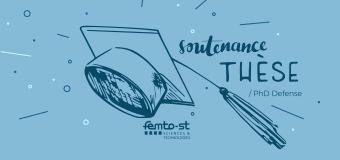You are here

Sheler MAKTOOBI : "Diffractive coupling for optical neural networks"
Tuesday 21 July - 10.00 AM15B Avenue des Montboucons
25030 Besançon cedex
France
PhD works of Sheler MAKTOOBI : "Diffractive coupling for optical neural networks"
Although the defense is public, the sanitary measures currently in force limit the number of people allowed in the amphitheatre. Only those invited will be able to attend the oral presentation.
Abstract : Photonic networks with high performance can be considered as substrates for future computing systems. In comparison with electronics, photonic systems have substantial privileges, for instance the possibility of a fully parallel implementation of networks. Recently, neural networks have moved into the center of attention of the photonic community. One of the most important requirements forparallellarge-scalephotonicnetworksistorealize the connectivities. Diffraction is considered as a method to process the connections between the nodes (coupling) in optical neural networks. In the current thesis, we evaluate the scalability of a diffractive coupling in more details as follow:
First, we begin with a general introductions for artificial intelligence, machine learning, artificial neural network and photonic neural networks. To establish a working neural network, learning rules are an essential part to optimize a configuration for obtaining a low error from the system, hence learning rules are introduced (Chapter 1). We investigate the fundamental concepts of diffractive coupling in our spatio-temporal reservoir. In that case, theory of diffraction is explained. We use an analytical scheme to provide the limits for the size of diffractive networks which is a part of our photonic neural network (Chapter 2). The concepts ofdiffractivecouplingareinvestigatedexperimentally by two different experiments to confirm the analytical limits and to obtain maximum number of nodes which can be coupled in the photonic network (Chapter 3). Numerical simulations for such an experimental setup is modeled in two different schemes to obtain the maximum size of network numerically, which approaches a surface of 100 mm2 (Chapter 4). Finally, the complete photonic neural network is demonstrated. We design a spatially extended reservoir for 900 nodes. Consequently, our system generalizes the prediction for the chaotic Mackey–Glass sequence (Chapter 5).
Jury composition :
Daniel BRUNNER, Chargé de recherche, Université Bourgogne - Franche-Comté, PhD Director
Sylvain BARBAY, Directeur de recherche, Université Paris-Saclay, Palaiseau, Reporter
Miguel ALONSO, Professeur, Université Rochester, Rochester (USA)/ Université Aix-Marseille, Marseille (France), Reporter
Damien RONTANI, Maître de conférences, Ecole Supérieure d’Electricité, Metz, Reviewer
Maxime JACQUOT, Professeur, Université Bourgogne - Franche-Comté, PhD co-director
Luc FROEHLY, Chargé de recherche, Université Bourgogne - Franche-Comté, PhD co-director
Localization : Amphithéâtre JJ Gagnepain, Bâtiment TEMIS, Institut FEMTO-ST, 15B, Avenue des Montboucons, 25000 Besançon









